ascob
n. a cocker spaniel of “any solid color other than black”
Author: Greg Ross
Tandem
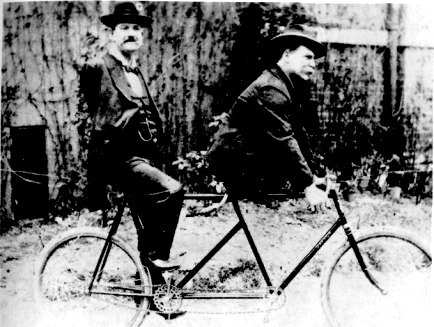
“Armless Wonder” Charles B. Tripp and “Legless Wonder” Eli Bowen share a bicycle, from a publicity shoot in the late 19th century.
Each man spent more than 50 years in the circus world — Tripp could write, paint, cut paper, and do carpentry with his feet, and Bowen trained himself to tumble and do stunts on a long pole. But apart from this photo, there’s no clear evidence that the two worked as a team.
Hope and Change
On April 12, 2006, numismatist Scott A. Travers bought a pretzel in Times Square and paid for it partly with a 1914 penny worth $350.
In the same week he spent a 1908 penny worth $200 and a 1909 one worth more than $1,000. “I’m planting a seed,” he told the New York Times, “and I hope that a new generation of people will come to appreciate the history that coins represent.”
In the weeks that followed, seven people came forward claiming to have found the $1,000 penny. “The coins were real, but none of them was mine,” Travers said.
In January 2009, the New York Daily News reported that all three of Travers’ coins were still unclaimed. That doesn’t mean they’re still circulating — but they might be.
Meeting a Local
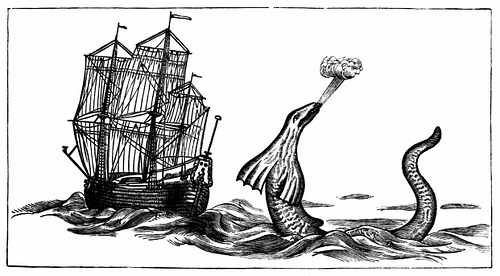
In 1740, Norwegian pastor Hans Egede published an account of an extraordinary encounter during one of his missionary voyages to Greenland:
Anno 1734, July. On the 6th. appeared a very terrible sea-monster, which raised itself so high above the water, that its head reached above our main-top. It had a long sharp snout, and blew like a whale, had broad, large flappers, and the body was, as it were, covered with a hard skin, and it was very wrinkled and uneven on its skin; moreover on the lower part it was formed like a snake, and when it went under water again, it cast itself backwards and in so doing it raised its tail above the water, a whole ship-length from its body.
He gives a similar account in A Description of Greenland, published five years later. Eric Pontoppidan, who became bishop of Bergen in 1746, wrote in his Natural History of Norway, “I have hardly spoke with any intelligent person born in manor of Nordland, who was not able to give a pertinent answer, and strong assurances the existence of this fish; and some of our north traders, that come here every year their merchandise, think it a very strange question, when they are seriously asked whether there be any such creature; they think it as ridiculous as if the question was put them whether there be such fish as eel or cod.”
“Boat Moved by a Rope”
There is a form of boat-racing, occasionally used at regattas, which affords a somewhat curious illustration of certain mechanical principles. The only thing supplied to the crew is a coil of rope, and they have, without leaving the boat, to propel it from one point to another as rapidly as possible. The motion is given by tying one end of the rope to the after thwart, and giving the other end a series of violent jerks in a direction parallel to the keel. I am told that in still water a pace of two or three miles an hour can be thus attained.
The chief cause for this result seems to be that the friction between the boat and the water retards all relative motion, but it is not great enough to affect materially motion caused by a sufficiently big impulse. Hence the usual movements of the crew in the boat do not sensibly move the centre of gravity of themselves and the boat, but this does not apply to an impulsive movement, and if the crew in making a jerk move their centre of gravity towards the bow n times more rapidly than it returns after the jerk, then the boat is impelled forwards at least n times more than backwards: hence on the whole the motion is forwards.
— W.W. Rouse Ball, Mathematical Recreations and Essays, 1905
Immaterialism
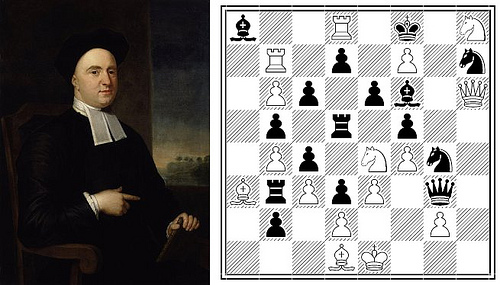
George Berkeley proposed that material things exist only because they are perceived to exist. In 1993, L.C. Rodó offered a suitably Berkeleyan puzzle in El Acertijo. Any piece, including a king, that is not regarded (attacked or guarded) by another piece disappears from the board. In the diagram above, every man is either attacked or guarded. But a single move (it may be by either White or Black) will set in motion a chain reaction in which all the pieces vanish from the board. What is the move?
Math Notes
2 × 5 × 27 = 1 × 15 × 18
2 + 5 + 27 = 1 + 15 + 18
213 × 624 = 312 × 426
102 × 402 = 201 × 204
936 × 213 = 639 × 312
Market Play
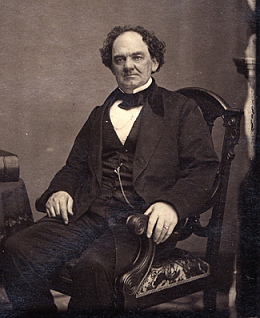
Barnum used to bring consternation into the hearts of his grocers by complaining that their pepper was half peas. When they protested, he would quietly ask, ‘How do you spell pepper?’ and the catch stood revealed.
— William Shepard Walsh, Handy-Book of Literary Curiosities, 1892
Sensual Gardening
While Tess of the d’Urbervilles was being serialized in the Graphic in 1891, Thomas Hardy’s editor objected to the scene in which Angel Clare carries Tess and her three dairymaid companions across a flooded lane. In the interests of propriety, the editor suggested that Angel use a wheelbarrow instead.
Hardy “carried out this unceremonious concession to conventionality with cynical amusement”:
‘Are you trying to get to church?’ he said to Marian, who was in front, including the next two in his remark, but avoiding Tess.
‘Yes, sir; and ’tis getting late; and my colour do come up so –‘
‘I’ll wheel you through the pool — all of you — with pleasure, you’ll wait till I get a barrow.’
The whole four flushed as if one heart beat through them.
‘I think you can’t, sir,’ said Marian.
‘It is the only way for you to get past, and there’s a barrow in that shed yonder.’ In a minute or two he had fetched the wheelbarrow and rolled it till it stood beneath them. ‘Now, Marian, attend,’ he continued, ‘and sit upon the top, and put your arms round my shoulders, so; or you’ll fall off. Now! Hold on. That’s well done.’
Hardy also had to remove the seduction scene and the christening of Tess’ illegitimate infant. The whole exercise was rather pointless — the “offensive” passages were restored in the first book edition that November.
Viviani’s Theorem
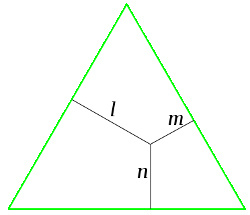
Pick any point inside an equilateral triangle and measure the distances to its sides.
The sum of those distances is the altitude of the triangle.
